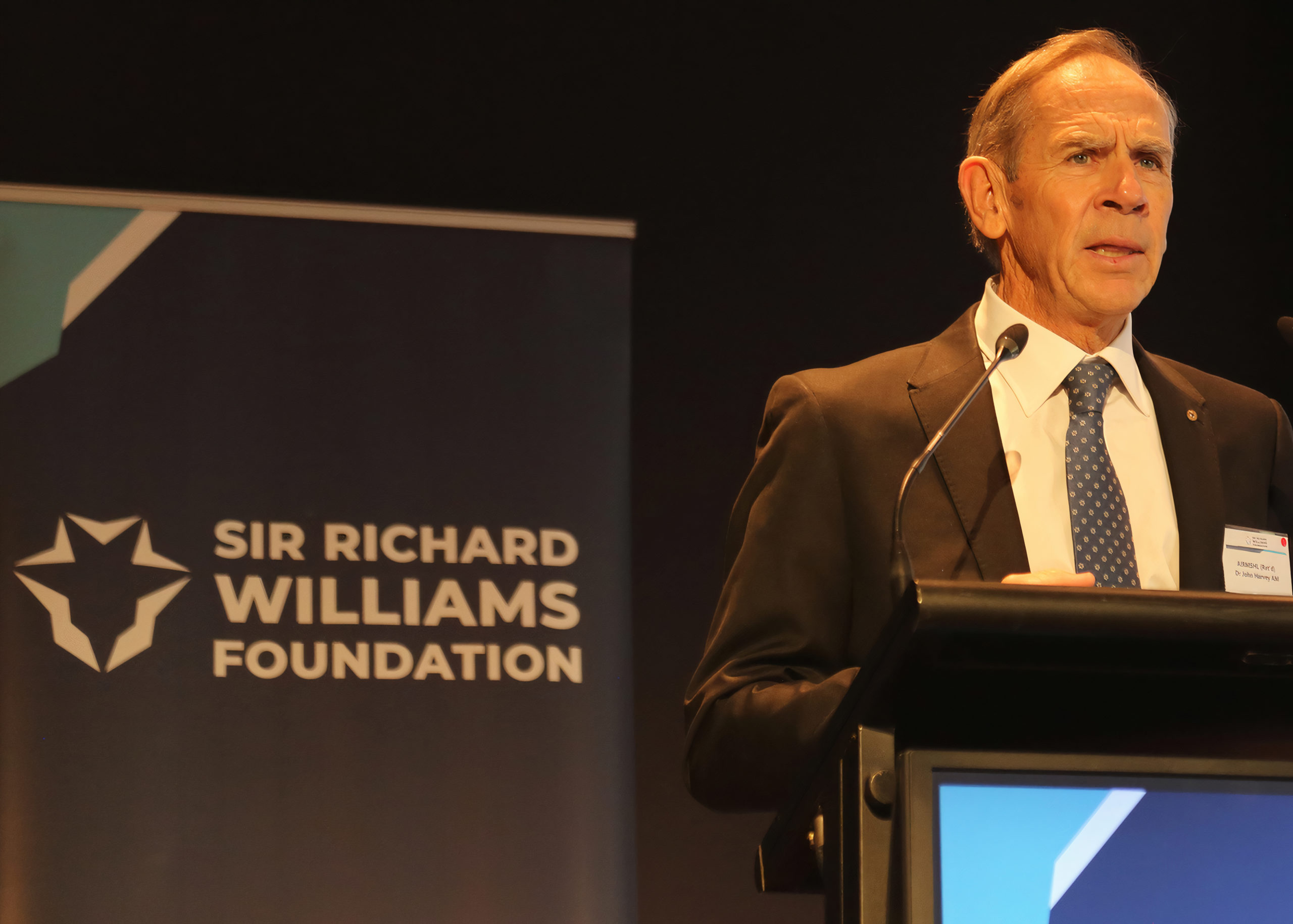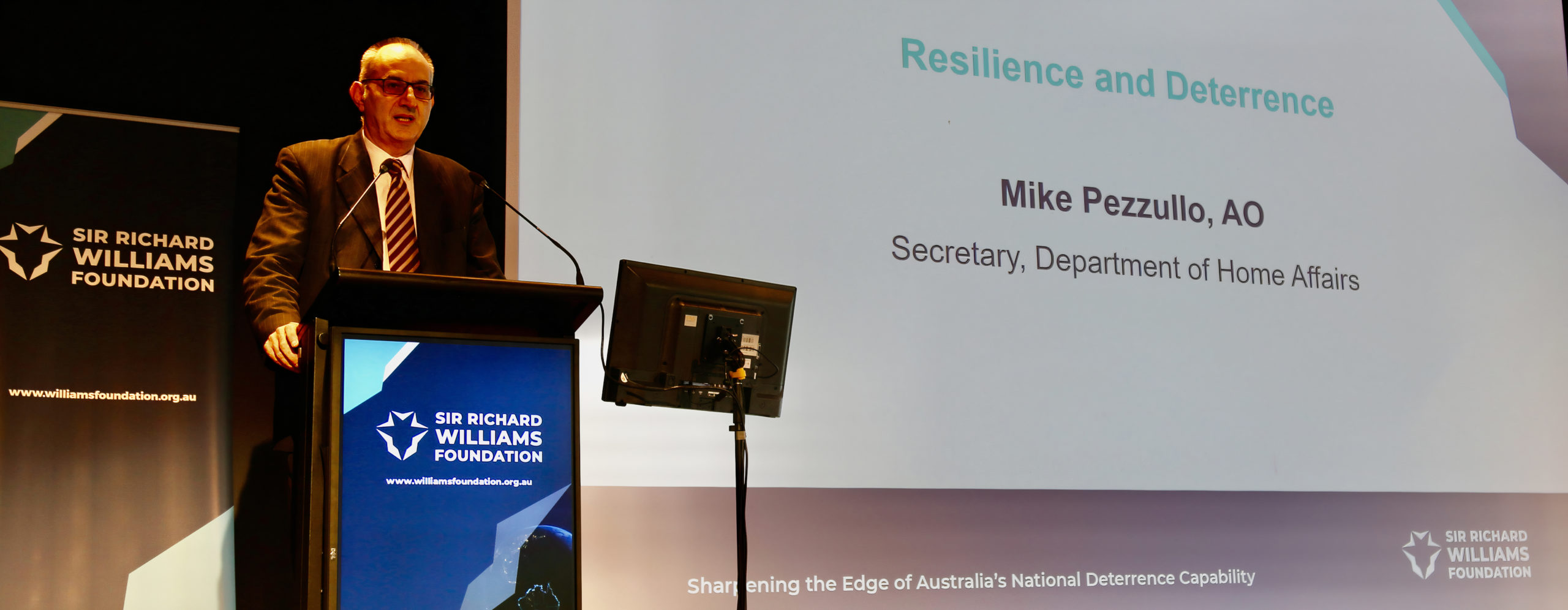Australia and Deterrence in a Global System in Flux
The Williams Foundation Seminar held on 30 March 2023 started a new phase of the foundation’s work on a broader look at how Australia can best shape effective and relevant deterrent capabilities in the context of significant global change.
The initial presentation to the seminar was by AIRMSHL John Harvey (Retd). He has written a well-regarded assessment of deterrence published in 1997 and in his presentation he looked back at that assessment as well as discussing the way ahead in the current decade.
His presentation focused largely on establishing a base-line understanding of deterrence, and in a meeting with him in the week after the seminar he discussed key challenges going forward.
Harvey noted that the “most common definition of deterrence is the following: “the threatened use of force to convince an adversary ‘not to do something.’
“There are three threat mechanisms on which deterrence is based: denial—where the aim is to defeat the aggressor’s forces involved in the potential hostile action; retaliation—where the aim is to exact a proportionate cost from the aggressor without necessarily directly defeating the attacking forces; punishment—where the aim is to raise the cost of aggression, through, for example, targeting the population of the aggressor force without necessarily targeting their military capability.”

Harvey then identified three determinants of the success of deterrence: capability –the ability to carry out the threat on which the deterrent threat is based; credibility—whether or not there is seen to be commitment to carrying out the deterrent threat; communication—how effective the deterrer is in communicating the threat to the potential aggressor.”
Harvey noted that deterrence is a means to an end, that it is “a tool at the service of policy.” He went on to argue that “at best, deterrence is a stabilizing mechanism—it cannot remove the source of tension in an adversarial relationship. It may, however, be essential in stabilizing a situation such that diplomatic and political solutions can be found.”
At the outset, Harvey stated that although the essentials of deterrence remained the same for Australia, there are significant changes since he wrote the book.
On the one hand, there are changes in the means. He identified two: “the importance of the information domain and the emergence of cyberwarfare; and the increased importance of space to military operations and space as a future warfare domain.”
On the other hand, there is a major geopolitical shift: “the rise of China as a major military power across all warfare domains, including nuclear weapons.”
If we add to this the significant shift in the alliance structure along with the adversarial set of challenges, the magnitude of the shift can be seen in terms of the deterrent challenge facing Australia.
As the Chief of Army, LTGEN Simon Stuart put it in his presentation: “Pax-Americana was an historic anomaly. The norm in human history is a violent transfer of power from one empire to another – and 14 of the 16 transitions between empires in human history have involved wars. We live in an era that might be described as post-peak globalisation. Understanding how the international system works, what the great economic or trading blocks are, is an endeavour we need to understand.”
I would add that understanding China as an adversary is a major task all on its own. We have a younger generation who grew up as beneficiaries of the benefits of the Chinese way of playing globalization. Why are they now an adversary?
China and Russia have operated within our societies in ways the Soviet Union could only dream of doing. A great term which captured this reality is the term Londongrad. Similar realities exist in the United States and Australia concerning the degree of Chinese involvement in our domestic lives.
And the significant deterrence history we generated in the 1980s is more an historical museum than a set of experiences to be learned from. And when you add to that the state of our knowledge of our authoritarian competitors and how their leaders define risk assessment and knowing what deters them, we face a real challenge. You cannot rely on funding from Confucius Institutes to train our own analytical capability on the nature of our competitors.
This means that shaping effective deterrence and practicing the art of statecraft for Australia and its allies in a world in flux will be difficult, challenging and not easily achieved. When I talked with AIRMSHL Harvey (Retd) the week following the seminar, he underscored the challenging nature of the transition.
In our discussion, Harvey underscored that what was required in the new context a whole of government, society and whole of alliance capability. With regard to mobilization, he made the very sound point that mobilization was important across the whole of government and society to deal with a variety of challenges, not just defence. Indeed, if one correlated mobilization simply with defence, that would lead to failure to focus on the much broader challenge which is best characterized by a capability for national resilience.
From this point of view, deterrence then is based on social cohesion and national cohesion to sustain Australia through the pressures which the changing global system puts upon her.
The presentation by Secretary Michael Pezzullo of the Department of Home Affairs indeed focused specifically on this question of the broader question of national resilience which was of enhanced importance in the new phases of Australian defence.
Pezzullo focused largely on the experience of Australia in World War II when the country was slow to respond to the threat but over time became mobilized to in fact deal with the challenges. Pezzullo cited Brendan Sargeant’s work on strategic imagination to make the point that “our capacity to envisage and prepare for the future is a function of the limits of our strategic imagination. The effective exercise of strategic imagination in the 1930s would have seen a better prepared and more resilient Australia.”

Pezzullo then noted: “Strategies are tasked with conceptual as well as particulars, different strategic assumptions, policy settings and operational capabilities, Australia’s part would have generated different risk calculations for Japan. Amongst other things Australia should have adapted a geographically focused strategy, which would have dictated the building of a different military force based around an air defense system across the north of Australia, a long-range bomber force, a larger army and a land force which was able to deploy to the Australian territories and Papua and New Guinea, across northern Australia and potentially into our new littoral region.”
Pezzullo concluded: “My thesis is in terms of resilience and deterrence, democracies will always be slow to start. Because we don’t focus on war. We don’t focus on conquest. And we don’t focus on the totalitarian aggregation of all functions of states around a single leader, around a single ideology for a single program. We live our lives. So we’re slow to stand, because we live freely.
“My contention is that history teaches us that we finish more strongly. And why is that? As you’ve seen that today in the Ukraine, the mobilization of consent is by popular will and organic and is not dictated and a ferocity that can overcome any tyrant and that is perhaps the ultimate deterrent.”
Clearly, we have now entered such a tine and how will the art of statecraft be combined with the enhanced deterrent effect of the ADF and allied military forces in the service of an effective practice of the art of statecraft?
If we look back at Sargeant’s essay referred to earlier, a number of the key challenges facing Australia and its allies are underscored:
“Two decades of ADF deployments to the Middle East and Afghanistan has built operational capability but perhaps at the cost of narrowing our ability to think strategically about our interests. This has been recognized, and recent policy statements such as the Defence Strategic Update 2020 have begun a process of reorientation to the Indo-Pacific as the area of our primary strategic concern. There have been the beginnings of an outreach towards other strategic relationships in our region, notably Japan and India, though this work is slow and will be very challenging.
“We have struggled to develop a confident position in relation to China, and we have perhaps been more optimistic than we should have been about China’s strategic ambition. This argues for a much more agile policy and a much more aggressive approach to the construction and management of our strategic interests. Others have framed this in terms of a stronger, more geographically centered regional focus in our policy and activity that might manifest itself in a much greater engagement with Indonesia and other South East Asian countries.
“I agree with this approach, but I would frame it also in terms of a much richer imaginative engagement with the Indo-Pacific more broadly, with a recognition that even as we have our own distinctive Australian identity, we are part of this community and that the nature of the community also shapes our identity and the way in which we might live in this world. Such an imaginative engagement might lead us to see what we might learn from the strategic traditions across the many Indo Pacific countries if we allow them to challenge our strategic imagination.
“We might also question why, as a community, we have in recent years made border protection the overriding policy and institutional imperative for the construction of our national security system, when the much larger and more strategically pressing issue is how we engage with the Indo-Pacific during a period of major change to the global strategic order? We might ask whether this preoccupation with the border constitutes the major contemporary failure of our strategic imagination..
“The work of policy, an art of desire, is to say what the world might be. The work of strategy is to create the path towards that world, responding to all the known and unknown impediments that are likely to emerge. Policy lives mostly in the world of imagination; strategy lives mostly in the world of experience. The art of the policy maker and the strategist is to bring imagination into the world of experience and through this to create strategy that can change the world. In times of great change, the challenge is to imagination, for continuity in strategy is likely to lead to failure. Sir Arthur Tange, an important figure in Australian foreign and defence policy making and strategy, once said that strategy without resources is no strategy.
“In my professional life those words were a touchstone. My argument now is that as we learn to live in the Indo-Pacific, strategy without imagination is sterile.”
Re-Thinking Australia’s National Security Strategy – Lessons from the 1930s for the 2030s
The Australian Defence Strategic Review: Lessons from the Past

